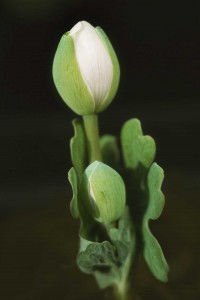Anticipating bloodroot
Originally published March 5, 2009

Bloodroot buds timidly rise in search of the warming sunlight. Photo by Betsy Green Moyer
By Ken Moore
I’m anticipating seeing bloodroot, Sanguinaria Canadensis, on a woods walk in the next couple of weeks. The common name refers to the reddish milky sap that exudes from a cut along the side of the finger-size rhizome. The root was a source for yellow to red-orange body painting and dyeing of clothing and baskets by Native Americans.
The petals of this common eastern American wildflower are as brilliant white as our recent fresh snowfall. Look for it on deciduous forest slopes scattered among ferns and other woodland plants. To catch the bloodroot in flower, you will have to take regular walks beginning soon. Once a bloodroot presents itself, you have only a few days time to catch the flower.
Plan your walk after mid-morning to catch the flower fully open in the warming sunlight. As the day cools, the petals close up. This action is repeated for several days and then the petals drop off, leaving an elongated pod that slowly swells through the spring to drop seeds that are quickly carried underground by ants. You may enjoy pondering why it spends so much energy closing and opening its petals.
Once you discover a bloodroot in flower, look around for more. See if you can find one still in bud, appearing timidly to poke its head up from the young leaf that wraps around the flower stem as it emerges.
Now that is anticipation!
If soil moisture is ample, the attractive lobed bloodroot leaf stays green well into the summer. Bloodroot is desirable for the woodland garden, and once established will naturally reseed. Niche Gardens and the N. C. Botanical Garden sell nice propagated plants. Call ahead if you wish to time your visit for bloodroot flowering at either location.
Bloodroot has such a rich herbal heritage that it must have been one of the staples in the medicine basket of Native Americans, akin to our own handy bottle of aspirin.
Medicinal use of the dried root included preparations of tonics for all kinds of internal ailments from colds to cancers, and salves applied to external injuries like axe cuts and just about every sort of skin irritation.
Now, before any of you take a notion to try any of the described remedies, heed well Dr. James Duke’s first comment about bloodroot in his Handbook of Northeastern Indian Medicinal Plants: “This plant is extremely poisonous.†Search for more information if you wish, but remember that Native Americans spent centuries observing and learning how to utilize this native herb.
My favorite description of the use of bloodroot comes from Paul Green’s Plant Book: “A tea made from the root is supposed, like carrots, to be good for the eyesight, also good for the nerves and coughs and colds. Two ounces of this tea in one pint of alcohol made a fine stimulant for both babies and rheumatic old men. The babies were allowed two teaspoonfuls for a dose once a day. The old men could suit themselves. In the latter case I doubt the pint lasted very long.â€
I don’t recommend you try this! I do recommend you get out soon on a bloodroot search, just for the beauty of it!

Snow-white petals of bloodroot open on warm sunny days to expose golden-yellow pollen-bearing anthers. Photo by Betsy Green Moyer


Comments are closed.